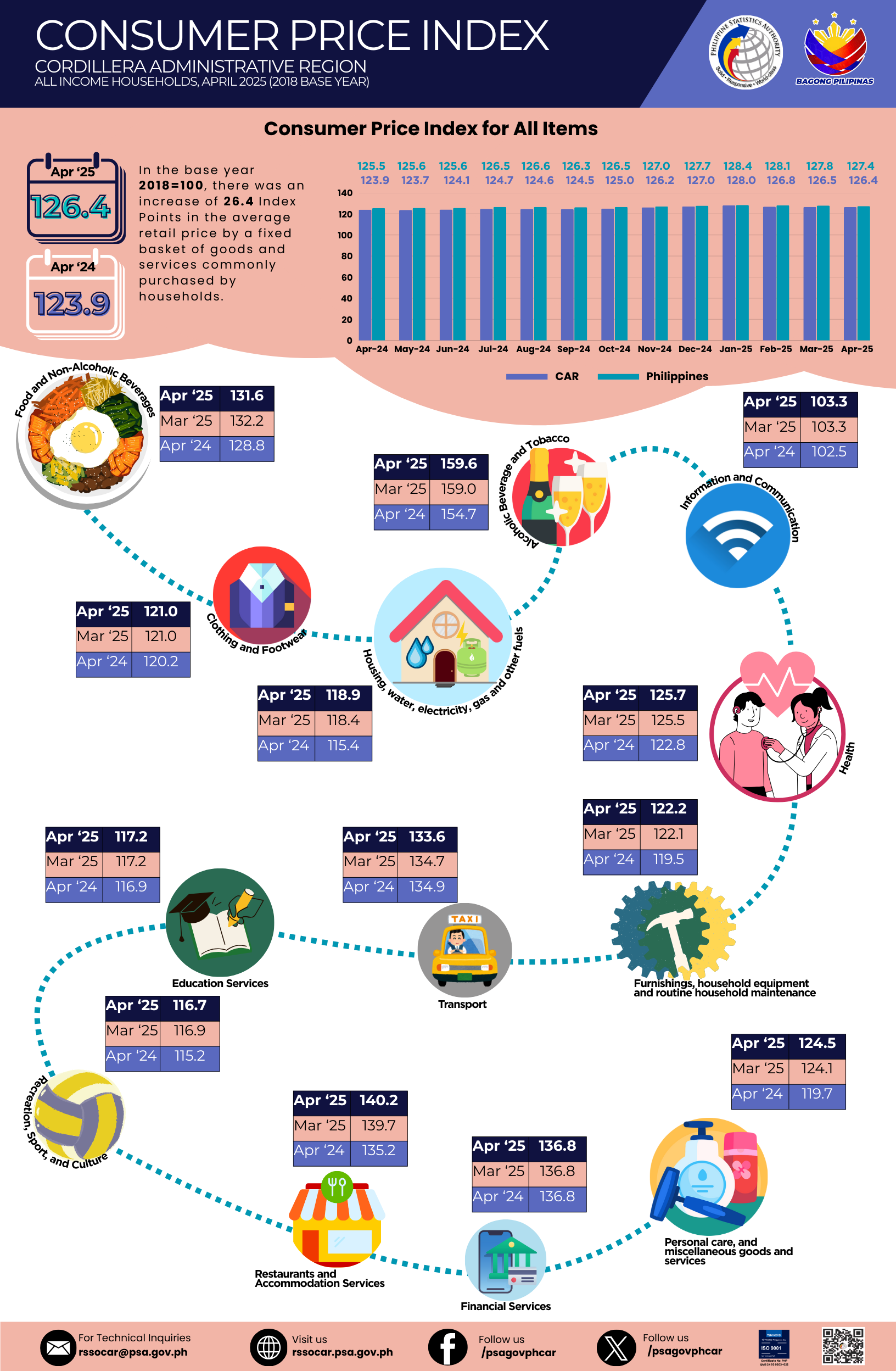Kalinga Headline Inflation Declines to 2.0% in July 2023
(BASE YEAR: 2018)
PRICE SITUATION: Year-on-Year
Kalinga’s inflation for the month of July 2023 is recorded at 2.0 percent, notably higher than the 8.0 percent posted in the same period a year ago. Likewise, this month’s inflation is slightly lower by 0.2 percent than the 2.2 percent recorded in June 2023.
The year-on-year situation is registered at 2.0 percent in all item indexes as an effect of the movement in prices in most commodities and service groups in July 2023 compared to the same period last year. Most of the following commodity groups reflected an increase: Alcoholic Beverages and Tobacco with 8.9 percent change (162.2 to 176.7); Furnishings Household Equipment and Routine Maintenance of the House with 8.0 percent change (122.2 to 132.0); Health with 6.5 percent change (129.5 to 137.9); Clothing and Footwear with 6.0 percent change (118.0 to 125.1); Personal Care, and Miscellaneous Goods and Services with 5.3 percent change (113.4 to 119.4); Food and Non-alcoholic Beverages with 4.3 percent change (115.0 to 114.9); ); Education Services with 3.5 percent change (122.2 to 126.5); Restaurant and Accommodation Services with 3.4 percent change (139.7 to 144.5); Recreation, Sport, and Culture with 2.1 percent change (111.8 to 114.1). On the contrary, a decrease was recorded in the price index of Transport with -0.87 percent change (131.0 to 119.6). Followed by Information and Communication with -0.6 percent change (102.0 to 101.4 and lastly Housing, Water, Electricity, Gas, and Other Fuels with -2,5 percent change (112.3 to 109.5). Meanwhile, the price index of Financial Services remained at 146.0.
PRICE SITUATION: Month-on-Month
In the month-on-month comparison, the consumer price index in All Items is posted at 0.3 percent higher from 121.2 to 121.6. The slow increase on the monthly CPI of the month was the result of the price increase of prices from the group of Housing, Water, Electricity, Gas, and Other Fuels with 0.5 percent change 109.0 to 109.5; Food and Non-Alcoholic beverages with 0.4 percent change from 119.4 to 119.9; Transport with 0.4 percent change from 119.1 to 119.6; Alcoholic Beverages and Tobacco with 0.3 percent from 176.2 to 176.7; Clothing and Footwear with 0.2 percent change from 124.9 to 125.1, and Furnishings Household Equipment and Routine Maintenance of the House with 0.2 percent change 122. to 132.0. Meanwhile, the price index of Financial Services, Health, Information and Communication, Education, Restaurant and Accommodation and Personal Care and Miscellaneous remain at 0 percent change.
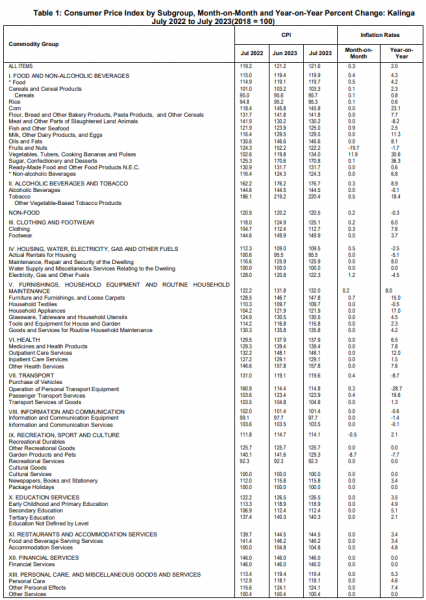
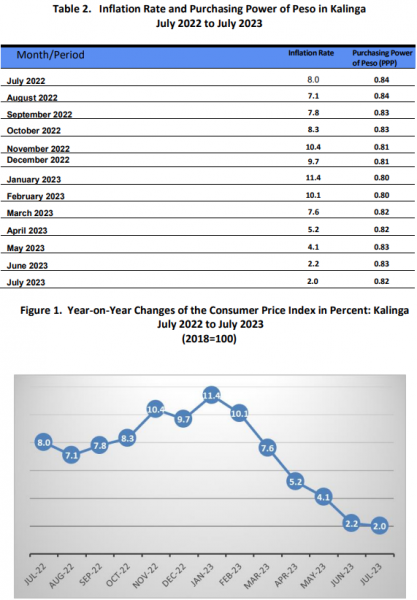
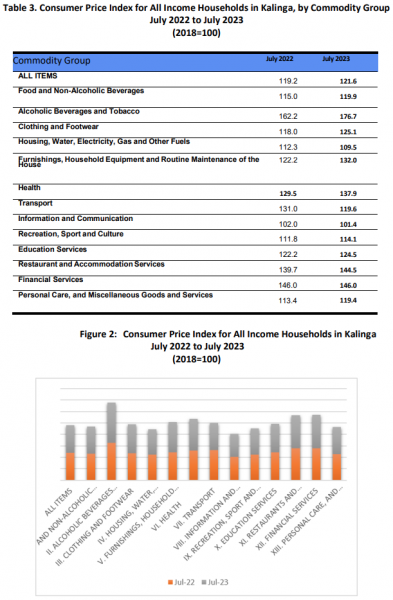
Purchasing Power of Peso
The Purchasing Power of Peso (PPP) in Kalinga was valued at 0.82 this July 2023, 2 centavos lower than the PPP of July 2022 with 0.84 centavos.
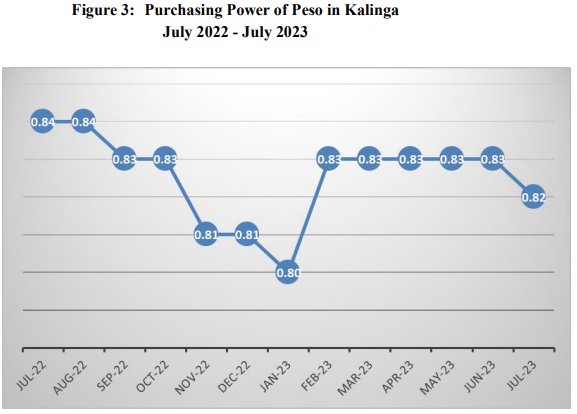
Technical Notes:
Price – is the amount or value paid in exchange for the commodity or a service rendered.
Retail/Consumer Price – refers to the price at which a commodity is sold in small quantities for consumption.
Weight – a value attached to a commodity or group of commodities to indicate the relative importance of that commodity or group of commodities in the market basket.
Market Basket – a term used to refer to a sample of goods and services that are commonly purchased and bought by an average Filipino household.
Consumer Price Index (CPI) – is a measure of the average change overtime in the prices paid by urban consumers for a market basket of consumer goods and services.
Inflation Rate - is the percentage increase or decrease in prices during a specified period, usually a month or a year and it is derived from CPI. It is interpreted in terms of declining purchasing power of money.
Unit of Measure - refers to which a commodity is customarily traded in the market and it is the actual unit in which the associated values are measured.
Commodity Specifications – refers to the detailed description of the commodity such as a brand packaging, size and unit of measure or other characteristics that will best describe the product/commodity and are important in the determination of prices.
Uses of the CPI
As an indicator, the CPI is the most widely used in the calculation of the inflation rate and purchasing power of the peso. It is a major statistical series used for economic analysis and as monitoring indicator of government economic policy.
The CPI is also used as a deflector to express value series in real terms, which is, measuring the change in actual volume of transaction by removing the effects of price changes. The CPI also serves as inputs in wage adjustments through the collective bargaining agreements.
MARIBEL M. DALAYDAY
Chief Statistical Specialist



